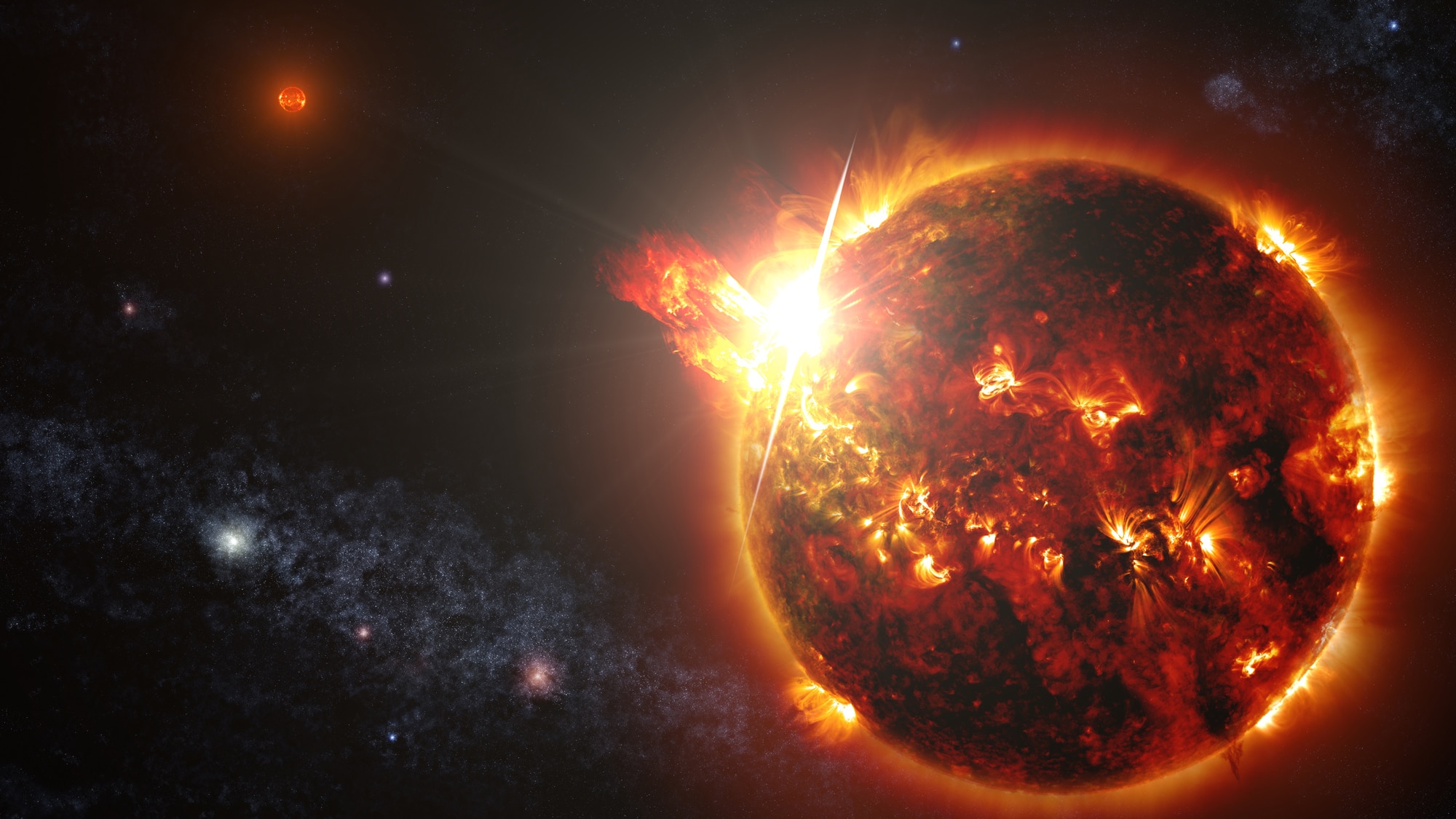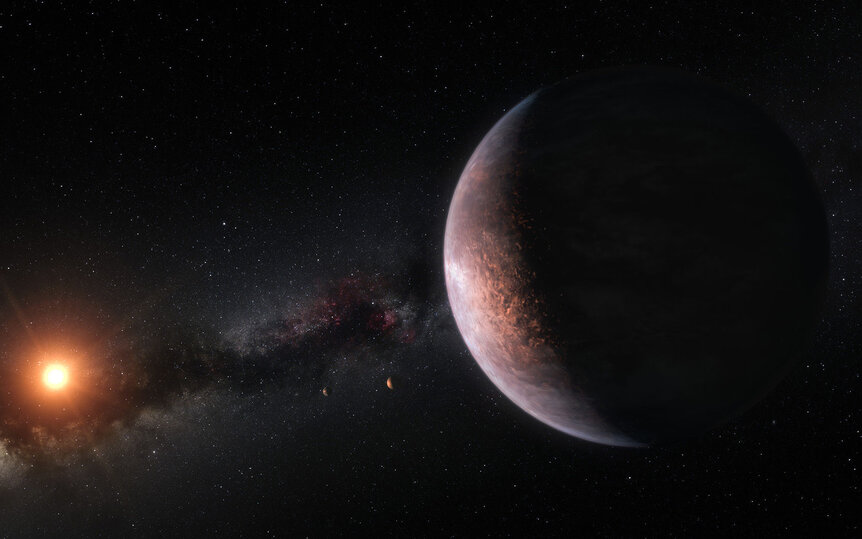Create a free profile to get unlimited access to exclusive videos, sweepstakes, and more!
Good news: Immensely powerful red dwarf superflares may not sterilize their planets

Any aliens living on a planet huddling close to a red dwarf star can breathe a sigh of relief (assuming they breathe, and can sigh, and feel relief): It’s possible extremely powerful explosive stellar flares don’t sterilize the planets as previously thought.
Maybe.
Red dwarf stars are much smaller, cooler, and dimmer than the Sun. Also unlike the Sun red dwarfs are fully convective, meaning hot plasma rises from their core all the way to their surface (in the Sun the convective region is much smaller). That may sound a bit esoteric, but it’s crucially important: The rising and falling ionized gas generates a magnetic field, and if a star is completely convective top to bottom (or really inside to outside) that means it can generate very powerful magnetic fields.
A star’s magnetic field is what powers explosive events on their surfaces like stellar flares and coronal mas ejections (or CMEs). The magnetic field lines store immense amounts of energy — like dwarfing all the nuclear weapons on Earth by thousands or millions of times immense — and when they tangle up they can, in a sense, short circuit and release that energy in a single soul-crushing explosion. A solar flare on the Sun can emit a decent fraction of the Sun’s total energy and it does it in X-rays and a flood of subatomic particles, both of which can short out our satellites, threaten astronauts in orbits, and cause widespread blackouts on Earth.
Coronal mass ejections are similar, and can be triggered by flares, but lean more toward the subatomic particle flood than emitting light. A billion tons (!!) of hydrogen can be blasted away from the Sun at a million kilometers per hour. An event like this is colossal and again can cause a lot of damage here on Earth.
This could be a much, much bigger problem for red dwarf planets. Red dwarfs are much more magnetically active than the Sun, and can produce superflares which can be up to ten thousand times more powerful than any the Sun produce. Worse, for a red dwarf planet to be habitable it has to huddle closer to the cooler star to support life, meaning it really takes the brunt of such flares.
This is such a big problem that astronomers think that the stellar activity can not just sterilize a planet but also strip away its atmosphere after some time.
Are red dwarf planet-inhabiting aliens doomed?
Maybe not, according to some new research. A team of astronomers used the Transiting Exoplanet Survey Satellite, or TESS, to examine the light from over 3,000 very cool red dwarfs, ones that were fully convective. TESS observes the same part of the sky over and over, making it ideal to look for changes in the stars’ brightness. They found over 17,000 flares from these stars, and narrowed that down to 343 superflare events.
What they wanted to find is what’s called rotational modulation: A flare that lasted long enough that the rotation of the star itself swept it into or out of our view, changing the flare’s brightness. They found four such events from four different stars ranging from 36 to 150 light years from Earth. All four spin rapidly, from 2.7 to 8.4 hours. Mind you, the Sun takes a month to rotate once, so these stars are whipping themselves around (rapid rotation also helps feed magnetic fields, so given they’re prone to superflares it’s not too surprising all these stars spin quickly).
They found the signature of rotation modulation in all these flares, meaning their brightness changed due to the star’s spin moving the flare into and out of our view. This is the cool and important part: From this they were able to figure out what latitude the flare occurred on the star, meaning if it was near the equator or near the pole.
What they found is that all four superflares occurred at high latitudes, closer to the pole than the equator, ranging from 55° to 81° (the pole is at 90°, the equator at 0°).
That’s very interesting indeed. Most sunspots and associated flare activity on the Sun occurs near the equator, rarely higher than 35° or so. But all these flares were much farther from the equator than that.
And this may be what saves any potentially habitable planets. Planets tend to orbit around their host star’s equator, and that’ll be especially true for red dwarf star planets, which experience stronger tides from their stars due to their proximity; this will force the planets to be above the equator.
But the flares happen closer to the stars’ poles, which reduces their impact. Well, a bit: High energy X-rays and ultraviolet tend to get blasted out in all directions, but this still reduces the effect somewhat. On the other hand, coronal mass ejections (which can be associated with flares) are directional, and tend to get focused above the flare. A flare at high latitude would therefore blast the CME away from the planets.
If true, this means those planets don’t get hit as hard or as often as previously thought.
Mind you, this conclusion is still a bit broad given the data. For example, CMEs expands as they move away from a star, so ones not aimed right at a planet might still affect it. Also it’s not clear how CMEs actually work from red dwarf stars since we can’t really detect them; we can only infer that from how they work with the Sun. So there’s more to figure out here.
But this is hopeful. Red dwarf stars are by far the most common in the galaxy, making up 80% of all stars, and they preferentially make small rocky planets like Earth. Just statistically then they are the most likely kinds of stars to have habitable planets (though the devil is in the details, as usual). The idea that they may be wiped clean of life by their host stars is a little depressing, so this conclusion, even if preliminary, is — pardon the expression — a ray of sunshine.




























